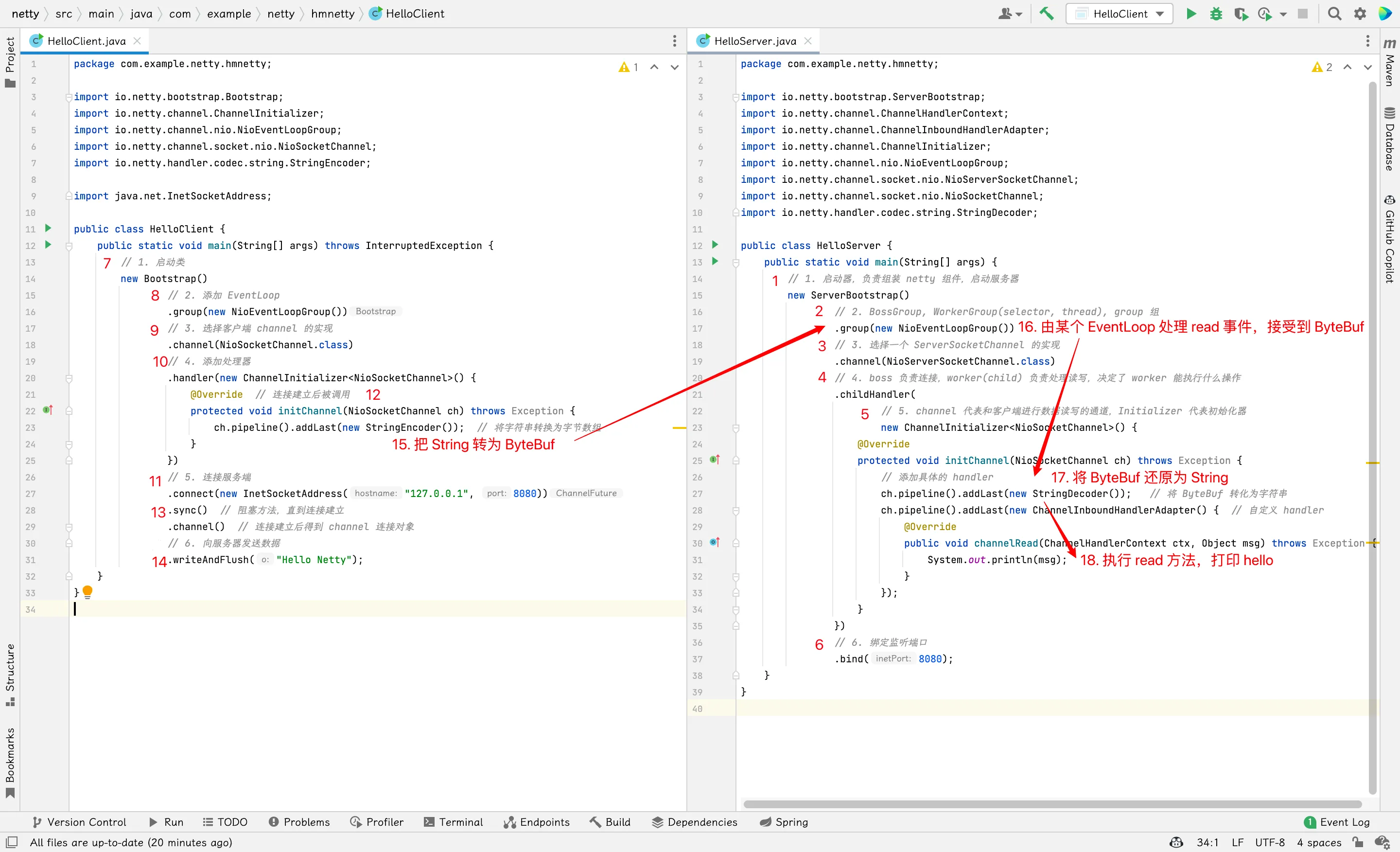Netty 黑马
Hello World

- 把 channel 理解为数据的通道
- 把 msg 理解为流动的数据,最开始输入是 ByteBuf,但经过 pipeline 加工,会编程其他类型对象,最后输入又变成 ByteBuf
- 把 handler 理解为数据的处理工序
- 工序有多道,合在一起就是 pipeline,pipeline 负责发布事件(读、读取完成…)传播给每个 handler,handler 对自己感兴趣的事件进行处理(重写了相应事件处理方法)
- handler 分 InBound 和 OutBound 两类
- 把 EventLoop 理解为处理数据的工人
- 工人可以管理多个 channel 的 io 操作,并且一旦工人负责了某个 channel,就要负责到底(绑定,工人-1—n-channel)(其实也保证了线程安全)
- 工人既可以执行 io 操作,也可以进行任务处理,每个工人有人无队列,队列里可以堆放多个 channel 的待处理任务,任务分为普通任务、定时任务(底层是单线程的线程池)
- 工人按照 pipeline 顺序,依次按照 handler 的规划(代码)处理数据,可以为没到工序指定不同的工人
组件
EventLoop
事件循环对象
本质是一个单线程执行器(同时维护了一个 Selector),里面有 run 方法处理 Channel 上源源不断的 io 事件
继承关系比较复杂
- 一条线是继承自
j.u.c.ScheduledExecutorService因此包含了线程池中所有的方法 - 另一条是继承自 Netty 自己的
OrderedEventExecutor- 提供了
boolean inEventLoop(Thread thread)方法判断一个线程是否属于此 EventLoop - 提供了 parent 方法来看自己属于哪个 EventLoopGroup
- 提供了
事件循环组 EventLoopGroup
是一组 EventLoop,Channel 一般会调用 EventLoopGroup 的 register 方法来绑定其中一个 EventLoop,后续这个 Channel 上的 io 事件都由此 EventLoop 来处理(保证了 io 事件处理时的线程安全)
- 继承自 Netty 的 EventExecutorGroup
- 实现了 iterable 接口提供遍历 EventLoop 的能力
- 另有 next 方法获取集合中下一个 EventLoop
Channel
- close() 用来关闭 channel
- closeFuture() 用户来处理 channel 的关闭
- sync 是同步等待 channel 的关闭
- addListener 是异步等待 channel 的关闭
- pipeline() 方法添加处理器
- writeAndFlush() 将数据写入并立即刷出
public class EventLoopClient { public static void main(String[] args) throws InterruptedException { NioEventLoopGroup group = new NioEventLoopGroup(); // 1. 启动类 ChannelFuture channelFuture = new Bootstrap() // 2. 添加 EventLoop .group(group) // 3. 选择客户端 channel 的实现 .channel(NioSocketChannel.class) // 4. 添加处理器 .handler(new ChannelInitializer<NioSocketChannel>() { @Override // 连接建立后被调用 protected void initChannel(NioSocketChannel ch) throws Exception { ch.pipeline().addLast(new StringEncoder()); // 将字符串转换为字节数组 } }) // 5. 连接服务端,这一步是「异步非阻塞」的,main 发起了调用,真正执行 connect 的是 nio 线程 .connect(new InetSocketAddress("127.0.0.1", 8080));
Channel channel = channelFuture .sync() // 处理方法 1: 阻塞当前线程,直到 nio 线程连接成功 .channel();
// 从控制台发送消息 new Thread(() -> { Scanner scanner = new Scanner(System.in); while (true) { String msg = scanner.nextLine(); if ("q".equals(msg)) { channel.close(); // 是异步操作 break; } channel.writeAndFlush(msg); } }, "input").start();
// 1) 同步处理方法 ChannelFuture closeFuture = channel.closeFuture(); System.out.println("waiting for close"); closeFuture.sync(); System.out.println("处理关闭后的操作"); group.shutdownGracefully();
// 2) 异步处理方法 /*closeFuture.addListener(new ChannelFutureListener() { @Override public void operationComplete(ChannelFuture channelFuture) throws Exception { System.out.println("异步处理关闭后的操作"); group.shutdownGracefully(); } });*/
// 6. 向服务器发送数据// channel.writeAndFlush("Hello Netty");
// 处理方法 2: 使用 addListener 回调对象)方法,异步处理结果 /*channelFuture.addListener(new ChannelFutureListener() { @Override public void operationComplete(ChannelFuture future) throws Exception { Channel channel = future.channel(); System.out.println(channel); channel.writeAndFlush("Hello Netty"); } });*/
}}Future & Promise
Caution
Netty 的 Promise 对 Netty 的 Future 进行了扩展
- JDK Future 只能同步等待任务结束(成功或失败)才能得到结果
- Netty Future 可以同步等待任务执行得到的结果,也可以异步方式得到结果,但是需要等任务结束
- Netty Promise 不仅有 Netty Future 的功能,而且脱离任务独立存在,只作为两个线程之间传递结果的容器
public class TestNettyPromise { public static void main(String[] args) throws ExecutionException, InterruptedException { // 1. 准备 EventLoop 对象 EventLoop eventLoop = new NioEventLoopGroup().next();
// 2. 可以主动创建 promise DefaultPromise<Object> promise = new DefaultPromise<>(eventLoop);
new Thread(()-> { // 3. 任意线程执行计算,计算完毕后向 promise 写入结果 try { Thread.sleep(1000); }catch (InterruptedException e){ e.printStackTrace(); } promise.setSuccess(80); }).start();
// 4. 接收结果 System.out.println("等待结果"); System.out.println("结果为:" + promise.get()); }}Handler & Pipeline
ChannelHandler 用来处理 Channel 上的各种事件,分为入站和出站两种。所有 Channel 连成一串,就成了 Pipeline
- ChannelInBoundHandlerAdapter 主要用于读取客户端数据,写回结果
- ChannelOutBoundHandlerAdapter 主要用于对写回结果进行加工